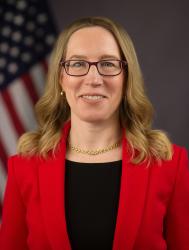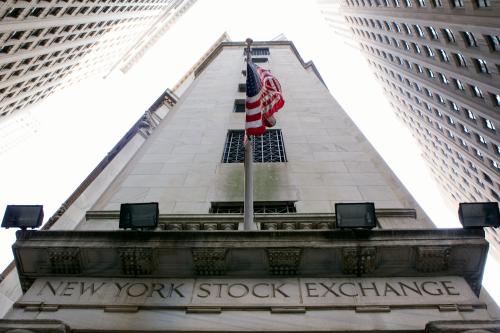This report is part of the Series on Financial Markets and Regulations and was produced by the Brookings Center on Regulation and Markets.
There has been much focus on the declining numbers of banks. Banks, however, are not unique in their dwindling numbers. This essay looks at the decline in broker-dealers (BDs) and futures commission merchants (FCMs). As with the decline in the number of banks, there are likely many factors behind the falling numbers. This essay calls for analysis of the reasons behind the drop in the number of BDs and FCMs, including the role regulation may be playing in the decline.
Introduction to Broker-Dealers and FCMs
BDs and FCMs play an essential role in enabling customers to participate in the securities and futures markets. In the securities markets, a broker is “any person engaged in the business of effecting transactions in securities for the account of others.”1 A dealer is a person engaged in the business of buying and selling securities for her own account.2 It is common for a firm to be both a broker and a dealer. BDs are not homogenous; they encompass a wide array of firms that perform a broad range of functions related to helping companies raise capital and ensuring that investors can buy and sell securities when they want to.3 BDs include independent firms with thousands of salespeople, subsidiaries of larger financial firms, and boutique BDs.
FCMs likewise are heterogeneous in the services they provide and the form they take. FCMs, among other things, enable farmers and companies to hedge their risks and provide customers access to exchanges and clearinghouses. FCMs can be subsidiaries of larger financial firms or smaller, independent firms. An FCM is generally anyone who “solicits or accepts orders to buy or sell futures contracts, options on futures, retail off-exchange forex contracts or swaps and accepts money or other assets from customers to support such orders.”4
Most BDs must register with and are regulated by the Securities and Exchange Commission (SEC) and the Financial Industry Regulatory Authority (FINRA). FCMs generally must register with and are regulated by the Commodity Futures Trading Commission (CFTC) and the National Futures Association (NFA). FINRA and NFA are non-governmental regulators that operate under government grants of authority. Exchanges such as the Chicago Mercantile Exchange and New York Stock Exchange, in their capacity as self-regulators, are another source of regulation and supervision for BDs and FCMs.
A look at the numbers
Policymakers have noted with alarm the declining numbers of small banks and have looked at whether and how regulation is contributing to the decline. Less attention has been paid to a similar phenomenon with respect to BDs and FCMs. The numbers are dramatic enough to warrant additional policymaker consideration and analysis of what, if any, role regulation is playing in the downward trend.
The number of BDs has declined fairly consistently over the last decade. In March 2017, there were 3,989 BDs registered with the SEC compared to 5,892 in March 2007, a more than thirty percent drop. Figure 1 shows how the numbers have changed over the past ten years. The downward trend is not new; the number of BDs fell approximately eight percent between 2001 and 2006.5
As Figure 2—which reports FINRA registrants—shows, however, the declines in branch offices6 and registered representatives—the individuals who sell securities—have not been as consistent or pronounced as the decline in registered firms. In BD consolidations, duplicative branch offices may be shut, but registered representatives are likely to be retained or move to a new firm.7
The FCM industry is much smaller than the BD industry. Figure 3 shows that there were 171 FCMs in March 2007, and only 64 in March of this year, a more than sixty percent decline. These numbers are slightly inflated as some of these firms are not active and others are affiliated with one another.8
Factors motivating the decline
There are many factors at work in the declining numbers of BDs and FCMs. Both industries are highly regulated, so regulation is likely an important factor. Figure 4 shows the amount of regulation—measured by counting regulatory restrictions—emanating from the SEC and CFTC—the regulatory agencies charged with regulating BDs and FCMs. Although not specific to BD and FCM regulation, the graph shows that regulation has increased quite substantially over time. CFTC regulatory restrictions have nearly doubled since 2000, and SEC restrictions have increased by almost thirty percent. By contrast, regulatory restrictions from all agencies have increased by approximately twenty-six percent in the same time period.9 The post-2010 spike in regulation was driven in large part by Dodd-Frank. Figure 4 does not reflect regulation by the exchange SROs, FINRA, NFA, and the Municipal Securities Rulemaking Board, which are additional important sources of regulatory obligations and costs.
Source: Patrick A. McLaughlin and Oliver P. Sherouse, RegData 3.0, http://regdata.org/ (May 10, 2017).
Note: RegData measures regulation by counting “the number of binding constraints or “restrictions,” words that indicate an obligation to comply such as “shall” or “must.” Mercatus Center at George Mason University, RegData, http://regdata.org/about/ For more information, see Al-Ubaydli, O. and McLaughlin, P.A. (2015) “RegData: A numerical database on industry-specific regulations for all United States industries and federal regulations, 1997-2012.” Regulation & Governance, doi: 10.1111/rego.12107.
It is not surprising that small BDs make up a disproportionate share of the BD decline10 and that industry observers anticipate further consolidation.11 It is also not surprising, as Figures 5-7, illustrate, that the FCM business is concentrated in a handful of large firms. Many regulations disproportionately burden small BDs and FCMs that are not subsidiaries of a larger firm with extensive compliance resources. There are more practical challenges for small firms too; large firms are better equipped to monitor regulatory developments, come into compliance with new requirements, and hire people with the necessary technical and compliance expertise. A post-Dodd-Frank survey of small banks, for example, revealed the strain that a set of new regulatory requirements, even when they include special accommodations for small entities, can pose.12 Mergers allow firms to spread regulatory and compliance costs—a portion of which are fixed—over a larger firm. Large firms also may find it easier to alert regulators and policymakers when rules are not working, although—as community banks have demonstrated—small firms acting collectively may be able to draw attention to unique small-entity challenges.
Regulation is not the only factor at play. Benefits from spreading fixed regulatory and non-regulatory costs across a larger firm drive consolidation.13 Downturns in the economy and troubled financial markets can also contribute to firm attrition. In addition, technology, which has changed the nature of the markets and the type of competition BDs and FCMs face, likely have a hand in the decline. Customer needs and demands also change over time, which may drive some firms out and draw other firms into the industry. The following sections look at some unique issues in each industry.
Potential factors in the decline of broker-dealers
The decline in the number of BDs is complicated by the wide variety of firms that are registered as BDs. One area in which there is substantial change is the retail BD landscape. More firms are moving away from commissions to an account-based fee model and many registered-representatives are dually registering as investment advisers. The Department of Labor’s fiduciary rule has not taken effect and is currently under review by the new administration, but it has already caused BDs to rethink their fee structures and business models. An Investment News survey of 57 independent BDs found “firms posting a 17.1% year-over-year increase [in operating costs] as a result of increased costs related to technology, compliance and training in preparation for the Labor Department’s now in-flux fiduciary rule.”14 The rule’s ongoing compliance costs and potential revenue implications are likely to play a role in future BD consolidation.
Although the fiduciary rule has been the primary regulatory event for retail BDs in recent years, Dodd-Frank’s far-reaching changes have affected the broader BD industry. Among other relevant provisions are the Volcker Rule, the enhanced regulatory framework for derivatives, and Public Company Accounting Oversight Board’s mandate to oversee auditors of BDs.
Regulation is not the only relevant factor affecting the entry, exit, and consolidation of BDs. Scale economies also apply to technology costs, and general economic conditions affect BDs along with other types of businesses.15 Financial market conditions may affect firm profitability and therefore firm survival. Business considerations also play a role in the number of BDs. For example, some banks are choosing to replace in-house BDs with third-party BDs.16
The declining numbers likely also reflect the changing nature of the markets in which BDs trade and the competition they face. Technology has given rise to new forms of competition for traditional retail BDs, including robo-advisers and online trading for investors. As low-cost index mutual funds and exchange-traded funds fill retail investors’ portfolios, BDs may play less of a role. Trading has become almost entirely electronic, extremely fast, and driven by algorithms and artificial intelligence; exchanges are no longer owned by their members, but arguably compete with them;17 and non-exchange trading venues—such as dark pools—have proliferated.
Potential causes for the decline in futures commission merchants
The number of FCMs has more than halved over the past fifteen years. Multiple factors are at work.18 Acting CFTC Chairman Christopher Giancarlo has likened FCMs to “an endangered species” and has blamed failed government policies—including monetary policy and regulatory policy—and several major FCM management failures.19 Giancarlo cites regulations related to ownership and control, recordkeeping, and capital and notes that the associated regulatory burdens fall disproportionately on “[s]maller FCMs that traditionally serve agricultural and small manufacturing interests.”20 Former CFTC Chairman Timothy Massad acknowledged that “there has been an increase among the top 10 firms in terms of what they hold,” but argued that many factors are at play, including “changes in business models, a low interest rate environment, changes in their profitability for various reasons, customer preferences perhaps, as to what kind of firms they want to deal with.”21
There have been a number of dramatic departures from the FCM industry in recent years. Refco’s FCM failed in 2005 as its parent company collapsed due to financial fraud. Sentinel failed in 2007 due to a failed investment strategy. MF Global failed in 2012, and the misuse of customer funds was central to the failure. Peregrine Financial failed in 2012 due to fraud by the firm’s owner.22 These failures drew renewed regulatory attention to FCMs, which led to new customer fund protections and reporting, disclosure, and risk management requirements. These regulatory changes have likely been especially difficult for small FCMs that are not associated with a larger financial firm. As the CFTC’s Giancarlo explains, although some of these rules “were undoubtedly needed,” they “have impacted small FCMs more harshly than large ones.”23 The FCM failures likely also caused the CFTC to take a harder line in enforcing FCM regulations,24 and may also have caused customers to avoid the markets FCMs serve.25
Regulatory developments unrelated to the notorious FCM failures also have added to the burdens faced by FCMs. Relevant Dodd-Frank changes include the law’s new swap rules and enhanced enforcement powers for the CFTC. Post-crisis changes in capital affect FCMs that are affiliated with banks. The supplementary leverage ratio, which is scheduled to take full effect in January 2018 but is already in the process of being implemented, supplements risk-based capital requirements by setting a minimum leverage ratio for large banking organizations. It places a particular burden on bank-owned FCMs because of the counterintuitive way it treats client margin.26 Acting CFTC Chair Giancarlo explains that by “reduc[ing] the already-narrow profit margins of bank-owned FCMs,” the supplementary leverage ratio “is causing many of the largest banking institutions to reduce their willingness be in the FCM business.”27 Regulatory burdens on clearing through FCMs has led clearinghouses to offer direct access to FCM clients,28 an option that could result in additional FCM closures.
Regulation is only one factor affecting profitability. Not only are FCMs “paying increasingly large sums to comply with new regulations, bolster their cyber security systems, and do business with exchanges,” but they are also earning less interest income from the investment of client funds and are having to back those funds with more capital.29 Low interest rates make FCMs less profitable, and the markets in which FCMs operate are becoming faster and demand more technological sophistication to compete. All of these factors likely drive financial firms’ decisions to sell some or all of their FCM business.30 The TABB Group, which has studied the FCM industry, nevertheless contends that the industry’s profitability is improving.31 Perhaps the downward trend will reverse itself—there was one new entrant in March of this year.
Implications of the declining numbers
The decline in BDs and FCMs raises a number of concerns. If industry exit and entry is driven by regulation, rather than by the economics of the marketplace, the industry can become non-competitive. Constrained competition decreases customer choice. Moreover, if regulatory barriers prevent new entrants with new ideas, technologies, and business models from displacing existing firms, customers may be denied higher quality or more affordable service. However, it is important to remember that regulation has sometimes harmed competition and caused there to be more firms than would otherwise exist. The fixed-commission rates (which were established through self-regulation) that prevailed in the brokerage industry until 1975 are one example.32 Historically prevalent branch banking restrictions are another.
If regulatory barriers prevent new entrants with new ideas, technologies, and business models from displacing existing firms, customers may be denied higher quality or more affordable service.
The impact of the declining numbers of firms may be of particular concern for individuals with small accounts and small companies. If a rural BD closes its doors, clients with small accounts may have trouble finding a convenient alternative. In the client swaps clearing business, the dominance of a small number of FCMs has raised concerns about the cost of and access to clearing for small derivatives users.33 And, as David Burton of the Heritage Foundation has pointed out, the disappearance of small BDs, who “are more willing to underwrite the offerings of small and start-up businesses,” could harm our economy.34
If consolidation leads business to concentrate in a handful of large firms, the consequences of one of those firms failing are likely to be worse than in a more dispersed industry.35 Acting CFTC Chair Giancarlo has pointed to several potential problems associated with concentration in the FCM industry, including “difficulties in transferring customer positions and margin in times of stress or an FCM default,” heightened systemic risk, impaired market function, and harm to customers “reliant on the intermediation of an FCM in our mandated clearing world.”36
Figures 5, 6, and 7 illustrate the concentration in the FCM industry. CFTC rules require FCMs to segregate funds in relation to their customer activity, so each firm’s required set-asides are indicative of its share of the customer business. These figures show that relatively few FCMs have most of the customer clearing business in connection with different types of customer activity. In each chart, the grey portion represents the share of the top ten firms.
The dominance of a handful of FCMs in each area may be consistent with a competitive, healthy market. Indeed, observers are not all of one mind about whether the concentration among FCMs is a cause for concern.37 Nevertheless, as firms leave the industry, there will be fewer to pick up the slack if one of the larger firms has an operational or other failure, such as already happened in several notorious instances in the futures industry. On the other hand, perhaps the ability of the industry to rebound after the failure of large FCMs illustrates that the markets can absorb even the failure of one of the key firms.
Conclusion
This essay highlights the decline in BDs and FCMs. While identifying some potential contributing factors, the essay primarily seeks to underscore the need for further analysis. Identifying the “right” number of BDs or FCMs is not a job for policymakers, but taking note of the decline in these firms and seeking to understand whether regulation is acting as an unwarranted barrier to entry and inducement to exit is a worthwhile undertaking. Competition generally serves customers well, and too much concentration may make our financial system less resilient in times of stress. To the extent regulation is to blame for some of the decline, regulators should consider whether regulatory objectives could be achieved effectively through less burdensome means.
Hester Peirce appreciates the research assistance of Conor Norris and Vera Soliman with this article.
The author did not receive financial support from any firm or person for this article or from any firm or person with a financial or political interest in this article. She is currently not an officer, director, or board member of any organization with an interest in this article.
-
Footnotes
- Securities Exchange Act § 3(a)(4)(A).
- Securities Exchange Act § 3(a)(5)(A).
- For a general discussion of BDs, see Daniel M. Gallagher, Broker-Dealer Regulation in Reframing Financial Regulation: Enhancing Stability & Protecting Consumers (Hester Peirce & Benjamin Klutsey, eds. Mercatus Center at George Mason University 2016). For a helpful breakdown of different BD business models, see Andre Cappon and Stephan Mignot, The Brokerage World Is Changing, Who Will Survive? Forbes (April 16, 2014), https://www.forbes.com/sites/advisor/2014/04/16/the-brokerage-world-is-changing-who-will-survive/print/.
- National Futures Association, Futures Commission Merchant,” https://www.nfa.futures.org/nfa-registration/fcm/index.HTML. See also 7 USC § 1a(28).
- See Angela A. Hung, Noreen Clancy, Jeff Dominitz, Eric Talley, Claude Berrebi, Farrukh Suvankulov, RAND Institute for Civil Justice Study for the SEC, Investor and Industry Perspectives on Investment Advisers and Broker-Dealers (2008), p. 36. The study reported that 5,526 firms filed Financial and Operational Combined Uniform Single (FOCUS) reports in 2001, compared to 5,068 in 2006. BDs with customer assets must file FOCUS reports. This essay’s BD numbers from 2007 through 2017 are based on a broader set of firms—“active broker-dealers who are registered with the SEC.” SEC, Frequently Requested FOIA Document: Company Information About Active Broker-Dealers, March 2007-May2017, https://www.sec.gov/help/foiadocsbdfoiahtm.html.
- Changes in how FINRA defines and interprets “branch office” over time may affect the number of branch offices.
- David R. Burton, Reforming FINRA, Heritage Backgrounder No. 3181 (February 2017), http://www.heritage.org/sites/default/files/2017-02/BG3181.pdf, at 10.
- J. Christopher Giancarlo, Commissioner, Commodity Futures Trading Commission, Statement for the Market Risk Advisory Committee (June 1, 2015), http://www.cftc.gov/PressRoom/SpeechesTestimony/giancarlostatement060115. Then-Commissioner Giancarlo pointed out that “[o]f the 72 FCMs registered with the CFTC as of March 2015, 15 firms were dormant, leaving only 57 active firms serving customers.”
- Patrick A. McLaughlin and Oliver P. Sherouse, RegData 3.0, http://regdata.org/ (May 10, 2017).
- See, for example, Jonathan Henschen, The Small Generalist Broker-Dealer: R.I.P? Who Will Survive?, ThinkAdvisor (April 10, 2014), http://www.thinkadvisor.com/2014/04/10/the-small-generalist-broker-dealer-rip-who-will-su?slreturn=1493667538. Henschen explains that “Like community banks, the number of broker-dealers continues to decline, with the lion’s share being small broker-dealers that closed or merged.”
- See, for example, Bruce Kelly, Independent Broker-Dealers Suffer Worst Year Since Credit Crisis, Investment News (April 25, 2016, 11:08 a.m.), http://www.investmentnews.com/article/20160425/FREE/160429966/independent-broker-dealers-suffer-worst-year-since-credit-crisis The story quotes Larry Papike, president of Cross-Search: “The growth in the IBD space over the next couple of years will come from the cannibalization of the weaker firms by the big firms . . . .”
- Hester Peirce, Ian Robinson, and Thomas Stratmann, How Are Small Banks Faring under Dodd-Frank? (Mercatus Center at George Mason University Working Paper No. 14-05 February 2014).
- See, for example, Subcommittee on Commodity Exchanges, Energy, and Credit of the Committee on Agriculture of the U.S. House of Representatives, Hearing to Review the Impact of Capital and Margin Requirements on End-Users (April 28, 2016),p. 46, https://www.gpo.gov/fdsys/pkg/CHRG-114hhrg20029/pdf/CHRG-114hhrg20029.pdf (testimony of Walter L. Lukken, President and CEO, Futures Industry Association) (explaining that the consolidation in the FCM industry reflects the need to spread fixed costs over a larger volume of transactions: “. . . more volume is necessary to flow through these intermediaries in order to make it a profitable business. And so you have people who are shuttering businesses, people who are merging, so you are seeing that over that period of time where people are deciding to either just get out of the business itself or to offer to try to merge those businesses in order to get more volume to go through those things.”).
- Matt Sirinides, Independent Broker-Dealer Revenue on the Decline: Firms Participating in the Investment News’ Annual IBD survey posted their first average year-over-year drop in revenue since the 2008 credit crisis, Investment News (April 22, 2017, 7:00 a.m.), http://www.investmentnews.com/article/20170422/BLOG18/170429968/independent-broker-dealer-revenue-on-the-decline.
- Ryan C. Fuhrman, Decline of the Independent Broker-Dealer, Investopedia (undated) (last visited May 1, 2017, 2:25 p.m.), http://www.investopedia.com/articles/professionals/050613/decline-independent-brokerdealer.asp. This analysis points to a number of factors, including: (1) consolidation driven by economic factors, including low interest rates and scale economies; (2) regulation, which larger firms are better able to comply with and influence; (3) regulation-driven technology costs, which large firms can more easily absorb; and (4) acquisition interest from large firms and private equity firms.
- See, for example, Margarida Correia, Bank-Owned Broker-Dealers Decline, BankInvestmentConsultant (April 2, 2014, 3:41 p.m.), https://www.bankinvestmentconsultant.com/news/bank-owned-broker-dealers-decline.
- See, for example, Cappon and Mignot, who argue that “[i]n some ways brokers and exchanges now compete with one another.”
- For a variety of views on the future of the FCM industry and forces driving the changes, see LynnStrongin Dodds, Mind the Clearing Gap—What’s Next for FCMs, DerivSource (June 18, 2015), https://derivsource.com/2015/06/18/mind-the-clearing-gap-whats-next-for-fcms/.
- J. Christopher Giancarlo, Commodity Futures Trading Commission, Statement for the Market Risk Advisory Committee (June 1, 2015), http://www.cftc.gov/PressRoom/SpeechesTestimony/giancarlostatement060115.
- J. Christopher Giancarlo, Commodity Futures Trading Commission, Statement for the Market Risk Advisory Committee (June 1, 2015).
- CFTC, Transcript of Market Risk Advisory Committee Meeting (June 2, 2015) (statement of Timothy Massad, Chairman, CFTC), http://www.cftc.gov/idc/groups/public/@aboutcftc/documents/file/mrac_060215_transcript.pdf at 172-173.
- For discussions of these failures and subsequent regulatory responses, see Anita K. Krug, Uncertain Futures in Evolving Financial Markets, Washington University Law Review, Vol. 93, pp. 1209-1269 (2016) and Jerry W. Markham, Custodial Requirements for Customer Funds, Brooklyn Journal of Corporate, Financial & Commercial Law, Vol. 8, pp. 92-133 (2013).
- J. Christopher Giancarlo, Commissioner, Commodity Futures Trading Commission, Statement for the Market Risk Advisory Committee (June 1, 2015).
- HLC Consulting LLC, Zero Tolerance for FCM Customer Fund Violations: CFTC Notches another Segregated Accounts Action on Technicalities (May 31, 2014), http://www.hlcconsultingny.com/single-post/2014/05/31/Zero-Tolerance-For-FCM-Customer-Fund-Violations-CFTC-Notches-Another-Segregated-Accounts-Action-on-Technicalities.
- For a discussion of customer unease following the failures of MFGlobal and Peregrine, see Tatyana Shumsky and Jerry A. DiColo, Futures Clients Ask: ‘Where’s my Money?’, Wall Street Journal (July 16, 2012, 12:21 p.m.), https://www.wsj.com/articles/SB10001424052702303644004577524923316973052.
- Former CFTC chairman Timothy Massad explained that “Under the SLR and the eSLR, margin for cleared derivatives is treated as an asset of the bank and is not permitted to be counted against the derivative exposure, and many believe this is not appropriate because margin is legally segregated.” Keynote Address before the Institute of International Bankers (March 2, 2015), http://www.cftc.gov/PressRoom/SpeechesTestimony/opamassad-13. See also Thomas C. Deas, Chairman, National Association of Corporate Treasurers, Prepared Testimony before the Senate Committee on Banking, Housing, and Urban Affairs, Hearing: Fostering Economic Growth: The Role of Financial Companies(March 28, 2017), https://www.banking.senate.gov/public/_cache/files/d774abf7-9c42-4698-b907-f2694bfb4ba3/E536A5C845F85021A15BF3D3048628FD.deas-testimony-3-28-17.pdf. Deas explains: The SLR does not permit the clearing member to take credit for the segregated initial margin posted by its customers, including end-users [and] segregated initial margin in the form of cash may be required to be added to a clearing member’s balance sheet exposure, requiring additional capital.”
- J. Christopher Giancarlo, Acting Chairman, CFTC, Remarks before the International Swaps and Derivatives Association 32nd Annual Meeting (Lisbon, Portugal May 10, 2017), http://www.cftc.gov/PressRoom/SpeechesTestimony/opagiancarlo-22.
- See Tom Lehrkinder, Growing Self-Clearing Trend Could Threaten FCMs, TABB Forum (August 29, 2016), http://tabbforum.com/opinions/growing-self-clearing-trend-could-threaten-fcms.
- John McCrank, Ranks of Commodities Brokers Dwindle as U.S. Futures Industry Evolves, Reuters (July 2, 2015, 4:39 a.m.), http://www.reuters.com/article/cme-landmark-brokers-idUSL1N0ZG14H20150701. See also Christian Berthelson and Tatyana Shumsky, SocGen Deal for Bache Illustrates Commodity-Trading Woe, Wall Street Journal (May 26, 2015, 7:07 p.m.), https://www.wsj.com/articles/socgen-deal-for-bache-illustrates-commodity-trading-woe-1432681628.
- See, for example, Joe Rennison, Nomura Exits Swaps Clearing for US and European Customers, Financial Times (May 12, 2015). The article explains that Nomura’s departure from client clearing of swaps follows the cost-motivated departures of Royal Bank of Scotland, State Street, and BNY Mellon.
- TABB Group, Press Release: “$4.5 Billion in Revenue Available for U.S. Futures Commission Merchants in 2016, According to TABB Group Study” (November 29, 2016, 8:30 a.m.), https://globenewswire.com/news-release/2016/11/29/893448/0/en/4-5-Billion-in-Revenue-Available-for-U-S-Futures-Commission-Merchants-in-2016-According-to-TABB-Group-Study.html The study’s author, Thomas Lehrkinder, explained that “FCMs have been treading water since the end of the financial crisis, but the sense from leaders of the community is that they have weathered the storm and the business will rise over time.”
- Andre Cappon and Stephan Mignot, The Brokerage World Is Changing, Who Will Survive? Forbes (April 16, 2014).
- The problem of “High clearing-related fees” is discussed in, ISDA, Research Note: Key Trends in Clearing for Small Derivatives Users (October 2016), at p. 6. The potential that FCMs will deny service to small customers is discussed in John McCrank, Ranks of Commodities Brokers Dwindle as U.S. Futures Industry Evolves, Reuters (July 2, 2015, 4:39 a.m.).
- David R. Burton, Reforming FINRA, Heritage Backgrounder No. 3181 (February 2017), at 10.
- This problem is discussed in John McCrank, Ranks of Commodities Brokers Dwindle as U.S. Futures Industry Evolves, Reuters (July 2, 2015, 4:39 a.m.).
- Remarks before the International Swaps and Derivatives Association 32nd Annual Meeting (Lisbon, Portugal May 10, 2017).
- Compare for example, Tod Skarecky, The Truth about FCM Concentration, Clarus Financial Technology (April 4, 2017), https://www.clarusft.com/the-truth-about-fcm-concentration/ with John P. Needham, 2016 Year-End FCM Financial Data, Needham Consulting blog (February 3, 2017), https://needhamconsulting.net. Skarecky tries to put the concentration of FCMs that clear swaps into perspective and concludes that “There are 19 active FCM’s clearing swaps. That seems like plenty.” Needham, by contrast, I thinks “that the concentration among just ten FCMs is a cause for worry” and “that the dwindling number of FCMs is a cause for genuine alarm.”
The Brookings Institution is committed to quality, independence, and impact.
We are supported by a diverse array of funders. In line with our values and policies, each Brookings publication represents the sole views of its author(s).

















